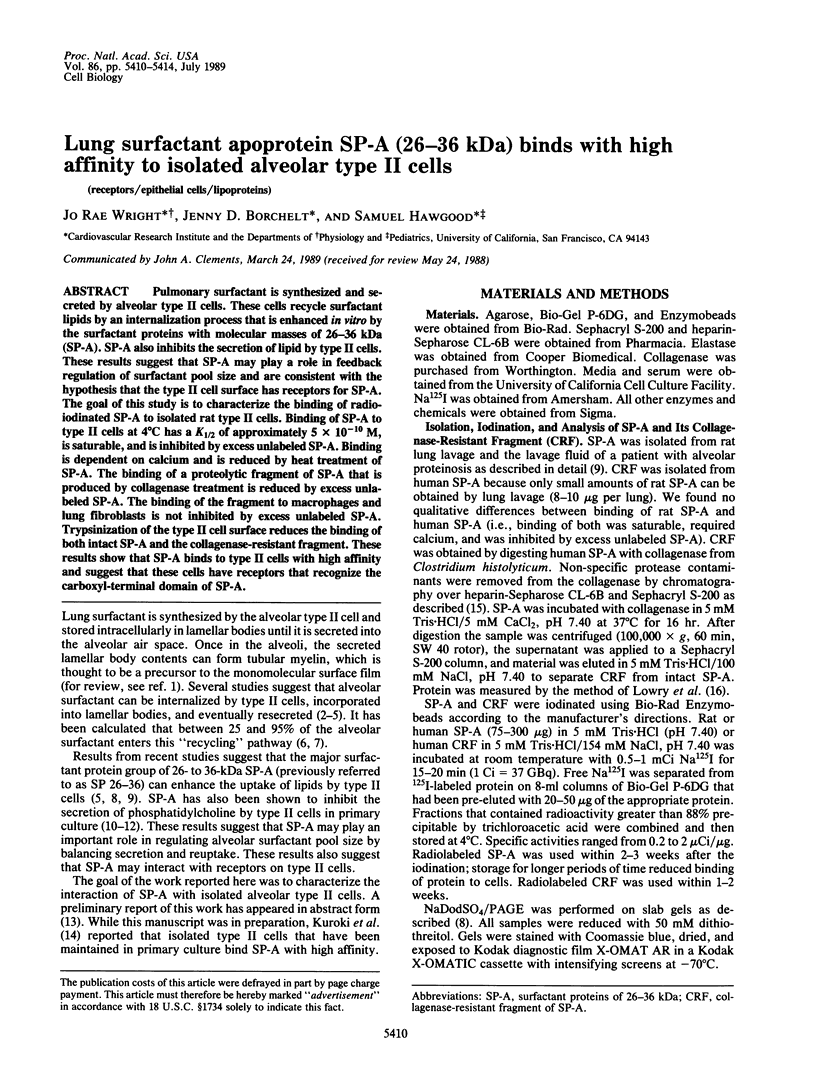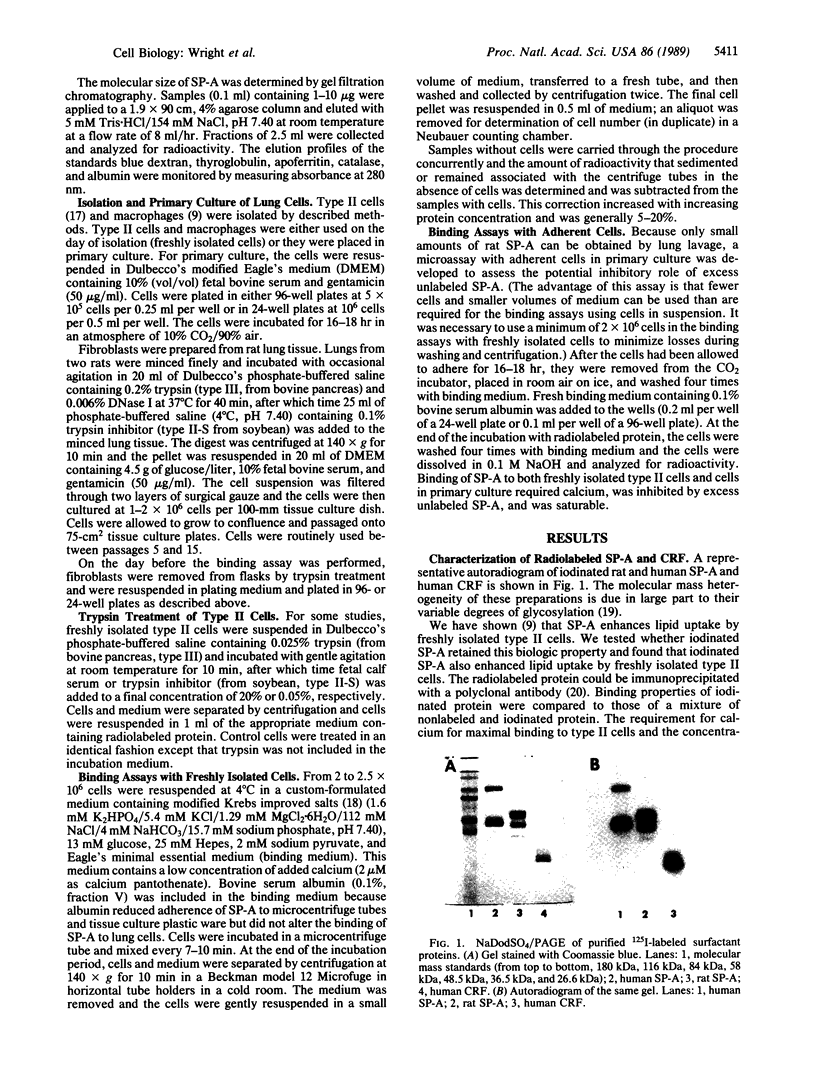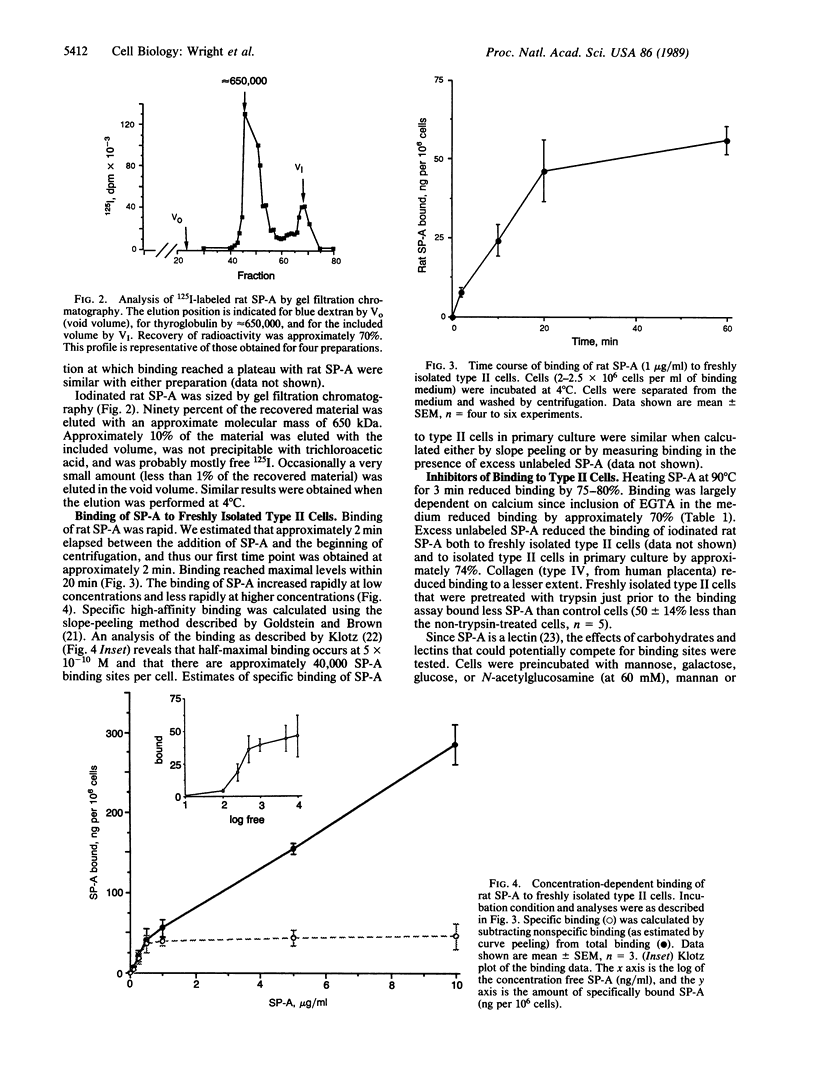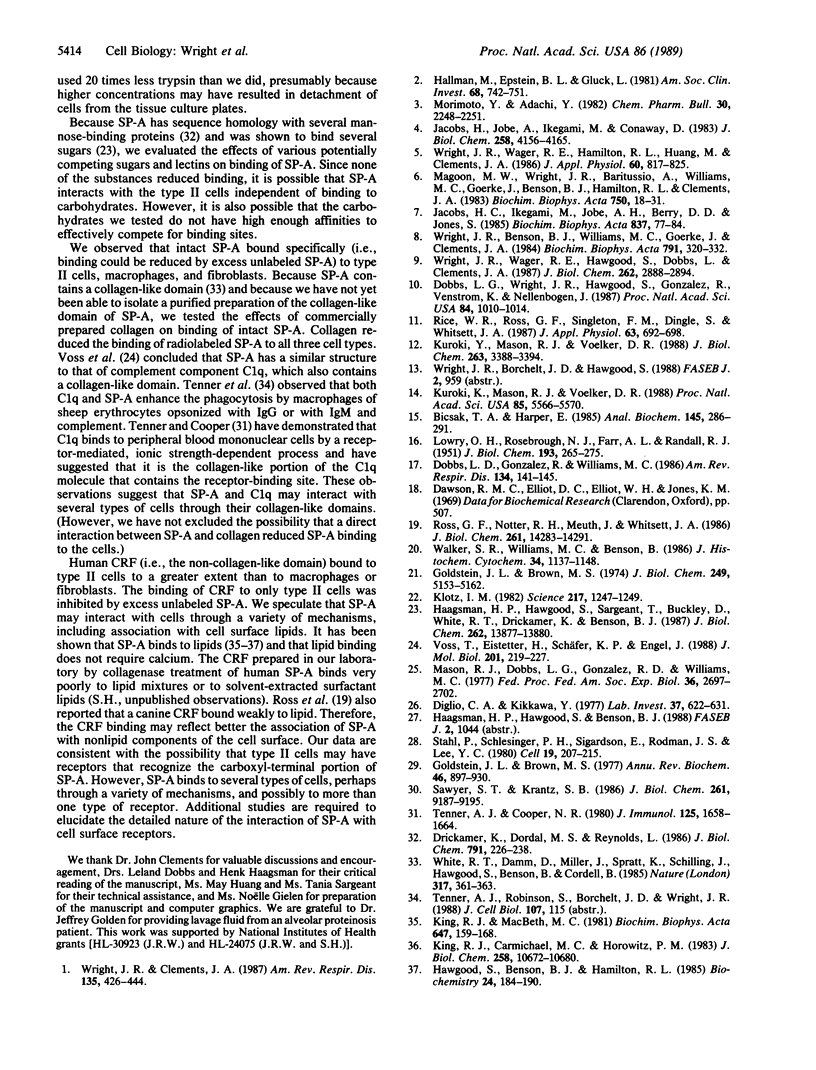Abstract
Pulmonary surfactant is synthesized and secreted by alveolar type II cells. These cells recycle surfactant lipids by an internalization process that is enhanced in vitro by the surfactant proteins with molecular masses of 26-36 kDa (SP-A). SP-A also inhibits the secretion of lipid by type II cells. These results suggest that SP-A may play a role in feedback regulation of surfactant pool size and are consistent with the hypothesis that the type II cell surface has receptors for SP-A. The goal of this study is to characterize the binding of radioiodinated SP-A to isolated rat type II cells. Binding of SP-A to type II cells at 4 degrees C has a K1/2 of approximately 5 X 10(-10) M, is saturable, and is inhibited by excess unlabeled SP-A. Binding is dependent on calcium and is reduced by heat treatment of SP-A. The binding of a proteolytic fragment of SP-A that is produced by collagenase treatment is reduced by excess unlabeled SP-A. The binding of the fragment to macrophages and lung fibroblasts is not inhibited by excess unlabeled SP-A. Trypsinization of the type II cell surface reduces the binding of both intact SP-A and the collagenase-resistant fragment. These results show that SP-A binds to type II cells with high affinity and suggest that these cells have receptors that recognize the carboxyl-terminal domain of SP-A.
Full text
PDF




Images in this article
Selected References
These references are in PubMed. This may not be the complete list of references from this article.
- Bicsak T. A., Harper E. Purification of nonspecific protease-free collagenase from Clostridium histolyticum. Anal Biochem. 1985 Mar;145(2):286–291. doi: 10.1016/0003-2697(85)90363-x. [DOI] [PubMed] [Google Scholar]
- Diglio C. A., Kikkawa Y. The type II epithelial cells of the lung. IV. Adaption and behavior of isolated type II cells in culture. Lab Invest. 1977 Dec;37(6):622–631. [PubMed] [Google Scholar]
- Dobbs L. G., Gonzalez R., Williams M. C. An improved method for isolating type II cells in high yield and purity. Am Rev Respir Dis. 1986 Jul;134(1):141–145. doi: 10.1164/arrd.1986.134.1.141. [DOI] [PubMed] [Google Scholar]
- Dobbs L. G., Wright J. R., Hawgood S., Gonzalez R., Venstrom K., Nellenbogen J. Pulmonary surfactant and its components inhibit secretion of phosphatidylcholine from cultured rat alveolar type II cells. Proc Natl Acad Sci U S A. 1987 Feb;84(4):1010–1014. doi: 10.1073/pnas.84.4.1010. [DOI] [PMC free article] [PubMed] [Google Scholar]
- Goldstein J. L., Brown M. S. Binding and degradation of low density lipoproteins by cultured human fibroblasts. Comparison of cells from a normal subject and from a patient with homozygous familial hypercholesterolemia. J Biol Chem. 1974 Aug 25;249(16):5153–5162. [PubMed] [Google Scholar]
- Goldstein J. L., Brown M. S. The low-density lipoprotein pathway and its relation to atherosclerosis. Annu Rev Biochem. 1977;46:897–930. doi: 10.1146/annurev.bi.46.070177.004341. [DOI] [PubMed] [Google Scholar]
- Haagsman H. P., Hawgood S., Sargeant T., Buckley D., White R. T., Drickamer K., Benson B. J. The major lung surfactant protein, SP 28-36, is a calcium-dependent, carbohydrate-binding protein. J Biol Chem. 1987 Oct 15;262(29):13877–13880. [PubMed] [Google Scholar]
- Hallman M., Epstein B. L., Gluck L. Analysis of labeling and clearance of lung surfactant phospholipids in rabbit. Evidence of bidirectional surfactant flux between lamellar bodies and alveolar lavage. J Clin Invest. 1981 Sep;68(3):742–751. doi: 10.1172/JCI110310. [DOI] [PMC free article] [PubMed] [Google Scholar]
- Hawgood S., Benson B. J., Hamilton R. L., Jr Effects of a surfactant-associated protein and calcium ions on the structure and surface activity of lung surfactant lipids. Biochemistry. 1985 Jan 1;24(1):184–190. doi: 10.1021/bi00322a026. [DOI] [PubMed] [Google Scholar]
- Jacobs H. C., Ikegami M., Jobe A. H., Berry D. D., Jones S. Reutilization of surfactant phosphatidylcholine in adult rabbits. Biochim Biophys Acta. 1985 Oct 23;837(1):77–84. doi: 10.1016/0005-2760(85)90087-6. [DOI] [PubMed] [Google Scholar]
- Jacobs H., Jobe A., Ikegami M., Conaway D. The significance of reutilization of surfactant phosphatidylcholine. J Biol Chem. 1983 Apr 10;258(7):4159–4165. [PubMed] [Google Scholar]
- King R. J., Carmichael M. C., Horowitz P. M. Reassembly of lipid-protein complexes of pulmonary surfactant. Proposed mechanism of interaction. J Biol Chem. 1983 Sep 10;258(17):10672–10680. [PubMed] [Google Scholar]
- King R. J., MacBeth M. C. Interaction of the lipid and protein components of pulmonary surfactant. Role of phosphatidylglycerol and calcium. Biochim Biophys Acta. 1981 Oct 2;647(2):159–168. doi: 10.1016/0005-2736(81)90242-x. [DOI] [PubMed] [Google Scholar]
- Klotz I. M. Numbers of receptor sites from Scatchard graphs: facts and fantasies. Science. 1982 Sep 24;217(4566):1247–1249. doi: 10.1126/science.6287580. [DOI] [PubMed] [Google Scholar]
- Kuroki Y., Mason R. J., Voelker D. R. Alveolar type II cells express a high-affinity receptor for pulmonary surfactant protein A. Proc Natl Acad Sci U S A. 1988 Aug;85(15):5566–5570. doi: 10.1073/pnas.85.15.5566. [DOI] [PMC free article] [PubMed] [Google Scholar]
- Kuroki Y., Mason R. J., Voelker D. R. Pulmonary surfactant apoprotein A structure and modulation of surfactant secretion by rat alveolar type II cells. J Biol Chem. 1988 Mar 5;263(7):3388–3394. [PubMed] [Google Scholar]
- LOWRY O. H., ROSEBROUGH N. J., FARR A. L., RANDALL R. J. Protein measurement with the Folin phenol reagent. J Biol Chem. 1951 Nov;193(1):265–275. [PubMed] [Google Scholar]
- Magoon M. W., Wright J. R., Baritussio A., Williams M. C., Goerke J., Benson B. J., Hamilton R. L., Clements J. A. Subfractionation of lung surfactant. Implications for metabolism and surface activity. Biochim Biophys Acta. 1983 Jan 7;750(1):18–31. doi: 10.1016/0005-2760(83)90200-x. [DOI] [PubMed] [Google Scholar]
- Mason R. J., Dobbs L. G., Greenleaf R. D., Williams M. C. Alveolar type II cells. Fed Proc. 1977 Dec;36(13):2697–2702. [PubMed] [Google Scholar]
- Morimoto Y., Adachi Y. Pulmonary uptake of liposomal phosphatidylcholine upon intratracheal administration to rats. Chem Pharm Bull (Tokyo) 1982 Jun;30(6):2248–2251. doi: 10.1248/cpb.30.2248. [DOI] [PubMed] [Google Scholar]
- Rice W. R., Ross G. F., Singleton F. M., Dingle S., Whitsett J. A. Surfactant-associated protein inhibits phospholipid secretion from type II cells. J Appl Physiol (1985) 1987 Aug;63(2):692–698. doi: 10.1152/jappl.1987.63.2.692. [DOI] [PubMed] [Google Scholar]
- Ross G. F., Notter R. H., Meuth J., Whitsett J. A. Phospholipid binding and biophysical activity of pulmonary surfactant-associated protein (SAP)-35 and its non-collagenous COOH-terminal domains. J Biol Chem. 1986 Oct 25;261(30):14283–14291. [PubMed] [Google Scholar]
- Sawyer S. T., Krantz S. B. Transferrin receptor number, synthesis, and endocytosis during erythropoietin-induced maturation of Friend virus-infected erythroid cells. J Biol Chem. 1986 Jul 15;261(20):9187–9195. [PubMed] [Google Scholar]
- Stahl P., Schlesinger P. H., Sigardson E., Rodman J. S., Lee Y. C. Receptor-mediated pinocytosis of mannose glycoconjugates by macrophages: characterization and evidence for receptor recycling. Cell. 1980 Jan;19(1):207–215. doi: 10.1016/0092-8674(80)90402-x. [DOI] [PubMed] [Google Scholar]
- Tenner A. J., Cooper N. R. Analysis of receptor-mediated C1q binding to human peripheral blood mononuclear cells. J Immunol. 1980 Oct;125(4):1658–1664. [PubMed] [Google Scholar]
- Voss T., Eistetter H., Schäfer K. P., Engel J. Macromolecular organization of natural and recombinant lung surfactant protein SP 28-36. Structural homology with the complement factor C1q. J Mol Biol. 1988 May 5;201(1):219–227. doi: 10.1016/0022-2836(88)90448-2. [DOI] [PubMed] [Google Scholar]
- Walker S. R., Williams M. C., Benson B. Immunocytochemical localization of the major surfactant apoproteins in type II cells, Clara cells, and alveolar macrophages of rat lung. J Histochem Cytochem. 1986 Sep;34(9):1137–1148. doi: 10.1177/34.9.2426341. [DOI] [PubMed] [Google Scholar]
- White R. T., Damm D., Miller J., Spratt K., Schilling J., Hawgood S., Benson B., Cordell B. Isolation and characterization of the human pulmonary surfactant apoprotein gene. 1985 Sep 26-Oct 2Nature. 317(6035):361–363. doi: 10.1038/317361a0. [DOI] [PubMed] [Google Scholar]
- Wright J. R., Benson B. J., Williams M. C., Goerke J., Clements J. A. Protein composition of rabbit alveolar surfactant subfractions. Biochim Biophys Acta. 1984 Dec 21;791(3):320–332. doi: 10.1016/0167-4838(84)90343-1. [DOI] [PubMed] [Google Scholar]
- Wright J. R., Clements J. A. Metabolism and turnover of lung surfactant. Am Rev Respir Dis. 1987 Aug;136(2):426–444. doi: 10.1164/ajrccm/136.2.426. [DOI] [PubMed] [Google Scholar]
- Wright J. R., Wager R. E., Hamilton R. L., Huang M., Clements J. A. Uptake of lung surfactant subfractions into lamellar bodies of adult rabbit lungs. J Appl Physiol (1985) 1986 Mar;60(3):817–825. doi: 10.1152/jappl.1986.60.3.817. [DOI] [PubMed] [Google Scholar]
- Wright J. R., Wager R. E., Hawgood S., Dobbs L., Clements J. A. Surfactant apoprotein Mr = 26,000-36,000 enhances uptake of liposomes by type II cells. J Biol Chem. 1987 Feb 25;262(6):2888–2894. [PubMed] [Google Scholar]



